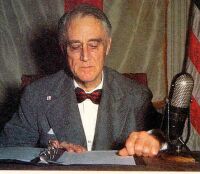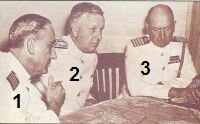
|
Whether or not President Roosevelt "allowed" the Japanese to sneak-attack Pearl Harbor, it is almost certain that the war shortened his life. |
|
FDR & PEARL HARBOR Did he know? The question that has gone unanswered for years. |

|
Whether or not President Roosevelt "allowed" the Japanese to sneak-attack Pearl Harbor, it is almost certain that the war shortened his life. |
|
Source: WWII Collector's Edition of the Pearl Harbor Magazine's Official 50th Anniversary Magazine, 1991, written by Blaine Taylor Ever since December 7th, 1941, revisionist historians of WWII have posed the question: Did President Franklin Delano Roosevelt know in advance of the top-secret Japanese plan to assault the United States Pacific Fleet based at Pearl Harbor, Hawaii? And if he did, why didn't he issue a warning that would have saved not only the Fleet, but thousands of American lives? I believe that FDR did know. This is my reasoning: by Blaine Taylor Throughout the 1930s, Japan was open in its admiration of Nazi Germany and in 1940 joined Adolph Hitler and Italian dictator Benito Mussolini in the Axis Pact. Roosevelt was convinced that Hitler's regime was morally corrupt. Germany had already gobbled up Austria, Czechoslovakia, Poland, Denmark, Norway, France, Belgium and Holland and by June 1941 had invaded the Soviet Union and was pounding Britain from the air. The President feared that without immediate American aid, both Russia and England would fall....and he knew from secret reports about the factory-like death mills the Nazis had set up in conquered Poland. FDR's problem was how to persuade the American people that they should enter the war. Polls showed that 80% of Americans were opposed to any involvement in what was seen as a European problem. Only a year earlier he had won an unprecedented third term in the Oval Office as a peace candidate. But now time was running out. Soon America would stand alone, without allies. Facing the combined resources of Europe and Asia, how could the United States hope to survive? The Axis powers had to be goaded into attacking the United States first. Only this, Roosevelt felt, would persuade the American people to join in the fight against fascist dictators. And his advisors agreed with him. With this goal in mind, starting in 1940, FDR waged an undeclared naval war against German U-boats in the North Atlantic. but this was not enough. He also sent the American Pacific Fleet from the West Coast to Pearl Harbor, hoping its easier access would tempt the Japanese. He figured correctly. The United States had broken the Japanese code in 1940 and thus must have been aware of the plans to attack Pearl Harbor. If FDR had warned the garrison, however, the Japanese would have intercepted the radio message and might have turned back. Since their entire air strike was predicated on achieving complete surprise, it is highly unlikely that Vice Admiral Chuichi Nagumo would have risked Japan's precious aircraft carriers on a mission whose secret had been revealed. From Roosevelt's point of view, if there was no attack, then there would be no American declaration of war against either Japan or Germany---and this was his primary objective. Precautions were taken. the American carriers, which were the likeliest Japanese targets, were moved out of Pearl Harbor, leaving mostly obsolete battleships left from World War I. but even if FDR granted his enemy the element of surprise, he had reason to hope that Pearl Harbor would be an American victory, as neither Japanese air power nor the Japanese fighting man had yet earned much respect in Washington. Over the first weekend of December 1941, none of FDR's top wartime leaders could be located---and for a very simple reason: they were all at the White House awaiting the attack which finally came on Sunday morning, Dec. 7. Admiral Husband E. Kimmel, the Navy's top man at Pearl Harbor, and Army General Walter Short were blamed for their lack of preparedness. Monday the President signed a bill stating that a state of war existed with Japan and by the end of the week Hitler had declared war on the United States. For the second time in the 20th century a global war raged. While the attack on Pearl Harbor united the nation and prompted it to take decisive action, the President had miscalculated the cost. Was he justified? Only history can make that judgment. |
| 2. Admiral Husband E. Kimmel, USN, the Navy's top man in Pearl Harbor, is flanked here by his Operations Officer, 1. Captain W. S. Kelaney and 3. Captain William W. Smith, his Chief of Staff. Following the attack, Kimmel is blamed---probably unjustly---for lack of preparedness at Pearl Harbor and the loss of the US Fleet. | 
|
|
Related Story: This Week around the World by William Ewing Related Story: Rear Admiral Husband E. Kimmel Canned Dec. 17th, 1941 Related Story: A Warning Ignored by Return to Pearl Harbor Index Return to |
|
The address to this page is fdr1941.htm Source: WWII Collector's Edition of the Pearl Harbor Magazine's Official 50th Anniversary Magazine, 1991, written by Blaine Taylor Dec. 13th, 2001 Permission to print from: Starlog Telecommunications, Inc., 475 Park Avenue South, New York, NY. 10016 Inside magazine states: Text by Blaine Taylor Blaine Taylor was a pictorial consultant on the Time-Life Book series "The Third Reich". His articles on military subjects have appeared in Soldier of Fortune, Gung-Ho!, New Breed, Air Classics, Sea Classics, Military, Vietnam: Chronicles of War, Military History, World War II, Vietnam, America's Civil War and Great Battles, among others. He gained first-hand knowledge of military operations serving at the U.S. Army's 25th Infantry division's Jungle and Guerilla Warfare Training Center in Hawaii and later with the 199th Light Infantry Brigade in Vietnam. |